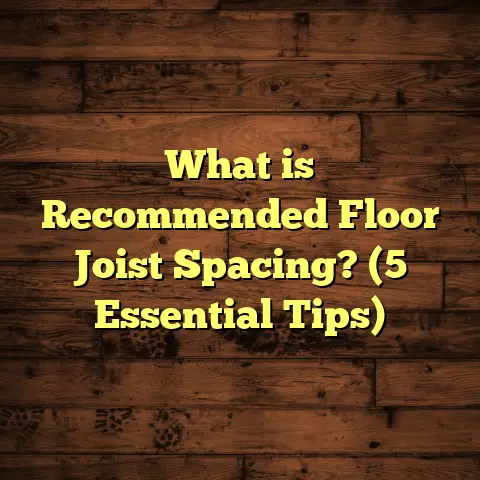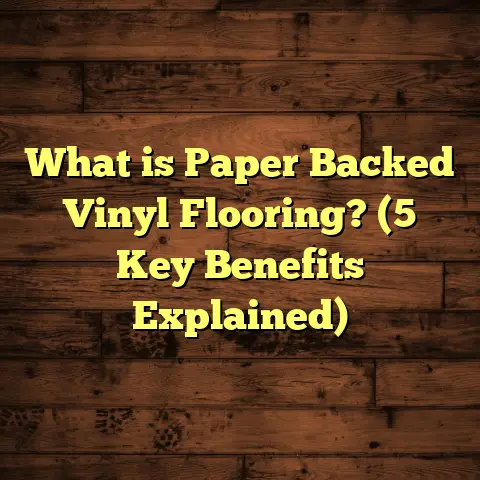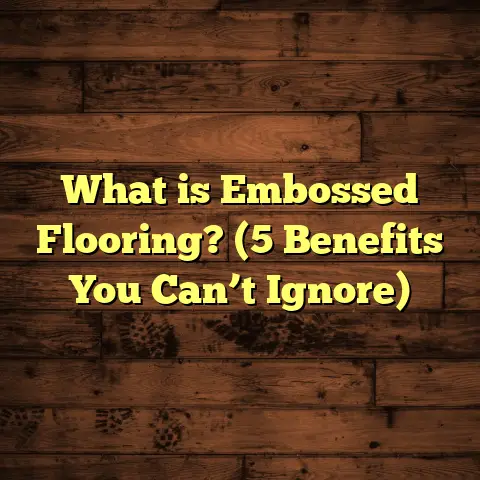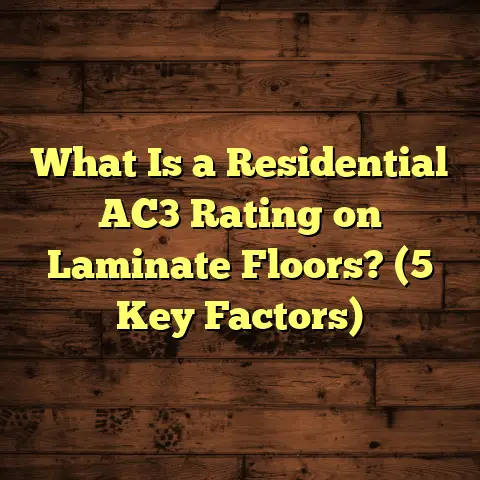What is Screening a Hardwood Floor? (5 Key Costs You Must Know)
“Quality is never an accident; it is always the result of intelligent effort.” – John Ruskin
I’ve been working with hardwood floors for over 15 years, and one process I often get asked about is screening. If you’re curious about what screening a hardwood floor means, how much it costs, or whether it’s right for your home, I’m here to share everything I’ve learned along the way. Let’s get into it.
What is Screening a Hardwood Floor?
Screening a hardwood floor is a light sanding process designed to refresh the surface without going all the way down to bare wood. Unlike full sanding, which removes several millimeters of wood to completely strip off old finish and imperfections, screening uses a fine abrasive mesh or screen—usually between 100-120 grit—to scuff the existing finish just enough for a new coat of finish to bond properly.
Think of it as giving your floor a gentle facelift rather than a full makeover. It smooths out minor scratches and dull spots and prepares the surface for refinishing without disturbing the wood beneath. This process is often called “screen and recoat” because after screening, a fresh layer of polyurethane or another finish is applied.
If your hardwood floors have slight wear but no deep dents or discoloration, screening can be the perfect solution. It’s less invasive, faster, and more budget-friendly than sanding down to bare wood.
Why Not Just Sand Every Time?
Sanding involves stripping the wood down to bare layers by using coarse sandpaper that removes about 1/16 inch (1.5 mm) or more of wood depth. While sanding is great for fixing deep damage or changing wood color, it shortens your floor’s lifespan because every sanding removes wood layers permanently.
Screening only affects the finish layer—usually less than 1/64 inch thick—so it preserves your hardwood’s structural integrity. The finish layer is typically about 3-5 mils (0.003-0.005 inches) thick, and screening lightly roughs this up without cutting into the wood itself.
What Does Screening Actually Do?
Screening does several important things:
- Removes minor scratches and scuffs
- Smooths out worn areas
- Eliminates surface gloss inconsistencies
- Prepares floor for new finish coat adhesion
- Removes light dirt and residue that won’t come off with cleaning alone
But remember, screening won’t fix deep stains, gouges, water damage, or uneven boards. For those problems, full sanding or replacement is needed.
My Experience with Screening Hardwood Floors
Early in my career, I had a client whose beautiful oak floors had lost their shine but were free from serious damage. Instead of pushing for a full sand, I recommended screening. We used a buffer fitted with abrasive screens and spent about 2 hours on the main living area, which was roughly 500 square feet.
The transformation was impressive. The floor regained its glossy look with no dust clouds or long downtime. The client was thrilled, and it became clear how screening offers a great balance between cost and quality.
Another time, I worked on a 1920s bungalow in Minneapolis where the pine floors had minor wear but lots of character. The homeowner wanted to keep that historic feel while refreshing the look. Screening followed by two coats of satin water-based finish brought out the grain beautifully without compromising the aged patina.
These experiences showed me how screening can extend the life of hardwood floors while saving money and time.
5 Key Costs You Must Know About Screening Hardwood Floors
Here’s where things get real: costs. If you’re planning to screen your hardwood floors, understanding the expenses involved will help you set a realistic budget.
1. Labor Cost
Labor for screening usually costs $0.50 to $1.00 per square foot depending on your location and contractor experience. In my area (Atlanta), I charge around $0.75 per square foot for screening and recoating.
For example, if you have 800 square feet of hardwood flooring, expect labor costs between $400 and $800. Screening takes less time than full sanding, so labor is cheaper—but it still requires skill for best results.
Labor rates vary depending on:
- Regional cost of living
- Contractor expertise and reputation
- Job complexity (room shape, furniture removal)
- Additional repair needs before screening
In high-cost cities like New York or San Francisco, expect to be at the higher end of that range or even above.
In smaller towns or rural areas, rates might be closer to $0.50 per sq ft.
2. Materials and Finish
The materials include abrasive screens and finishing products like polyurethane or water-based finishes. Abrasive screens cost roughly $10 to $20 per floor buffer pad set (enough for multiple rooms).
Finish products vary widely:
- Oil-based polyurethane: $30–$50 per gallon (covers ~350 sq ft)
- Water-based polyurethane: $40–$70 per gallon (covers ~350 sq ft)
- Aluminum oxide finishes (more durable): can cost more but last longer
For an average room, you might need 2 gallons of finish, costing around $60 to $140 total.
Water-based finishes dry faster and have less odor but tend to cost more upfront.
Oil-based finishes are cheaper but take longer to cure and have stronger fumes.
3. Equipment Rental (If DIY)
If you want to try screening yourself, renting a floor buffer with abrasive screens costs about $50 to $100 per day at local home improvement stores.
Keep in mind that poor technique can cause uneven finish or damage, so it’s not always recommended unless you’re confident.
You’ll also need to buy abrasive screens ($10-$20 per pack) and appropriate finish materials if you plan on recoating yourself.
4. Timeframe
Screening a typical 500-800 square foot room takes 1-3 days, including drying time for finishes (usually 4-6 hours per coat). I usually apply two coats after screening, so plan for at least two days before walking on the floor again.
Here’s a typical schedule:
| Day | Task |
|---|---|
| 1 | Move furniture & prep floor |
| 1 | Screen floor |
| 1 | Clean dust & apply first coat |
| 2 | Dry time & apply second coat |
| 3 | Dry time & furniture return |
Humidity and temperature affect drying times. If it’s humid or cold, finishes take longer to cure.
5. Additional Costs: Repairs and Cleaning
Sometimes minor repairs like filling small gaps or nail holes are needed before screening. These add $100 to $300 depending on damage extent.
Also, professional cleaning before screening might be necessary if the floor has built-up grime or residue from pets, smoke, or spills. This can add about $0.10-$0.20 per sq ft.
How Screening Compares to Other Floor Treatments
It helps to understand where screening fits compared to other options:
| Treatment | Depth Removed | Cost per Sq Ft | Timeframe | Dust & Mess Level | Best For |
|---|---|---|---|---|---|
| Screening & Recoat | <1/64 inch (finish) | $1 – $2 | 1-3 days | Low | Minor wear; dullness; scratches |
| Full Sand & Refinish | ~1/16 inch (wood) | $3 – $5+ | 3-7 days | High | Deep scratches; stains; damage |
| Buff & Polish | No removal | $0.50 – $1 | Same day | Minimal | Maintain shine between jobs |
| Replacement | N/A | Varies widely | Weeks (if ordered) | None | Severely damaged or old floors |
Screening sits in the middle: less invasive than sanding but more effective than simple buffing.
What Happens During Screening?
Here’s what I do step-by-step when screening floors:
Prep Work
Before starting, I remove all furniture and clean thoroughly using vacuum and damp mop. Any nails sticking up get hammered down to avoid damage to equipment.
Screening Process
Using a rotary buffer fitted with abrasive screens (100-120 grit), I work in overlapping passes along the wood grain. This light abrasion scuffs up the finish without cutting into wood fibers.
The key is consistent pressure and speed so the surface texture is even across the entire floor.
Dust Cleanup
Once done screening, I vacuum all dust carefully using HEPA filters to avoid redistributing fine particles into the air.
Applying Finish
Next comes applying two coats of finish using rollers designed for smooth application on hardwood floors.
Between coats, I lightly sand with very fine sandpaper (220 grit) to help adhesion.
Dry Time
Depending on product and conditions, each coat dries in 4-6 hours before applying another or walking on floors.
Final Inspection
After final dry time, I inspect closely for smoothness, bubbles, streaks, or missed spots and fix if necessary.
Troubleshooting Common Issues with Screening
I’ve seen some problems arise when screening isn’t done right:
- Uneven Finish: Happens if pressure varies or floor hasn’t been cleaned well.
- Finish Peeling: Usually caused by applying new finish over old that wasn’t adequately scuffed.
- Dust in Finish: Poor cleanup after screening leaves dust that settles in wet finish.
- Streaks or Marks: Buffer pad grit too coarse or uneven passes can leave marks.
If any of these happen, sometimes a quick touch-up with light sanding and re-coating fixes it; other times full sanding is necessary.
Case Studies from My Projects
Case Study #1: Mid-Century Modern Home in Austin, TX
A couple wanted their walnut floors refreshed without disrupting their packed schedule.
We screened ~900 sq ft over two days using water-based finish for low odor.
Total cost: Around $1,400 including minor gap repairs and furniture moving.
Result: Floors looked like new with satin sheen preserved original color beautifully.
Case Study #2: Rental Property in Boston, MA
Landlord wanted quick turnaround between tenants with minimal expense.
Screening saved them about $2 per sq ft compared to sanding/recoating.
We finished in one day with oil-based polyurethane for durability.
The property rented out within days at higher rate due to improved floor appearance.
How Often Should You Screen Hardwood Floors?
Most hardwood floors need screening every 3-5 years, depending on foot traffic and wear levels.
Heavy traffic areas like kitchens or hallways might need it closer to every 2 years; low traffic bedrooms could stretch up to 7 years between screenings if well maintained.
Regular cleaning and using rugs also extend time between screenings or sanding jobs.
Screening vs Buffing: What’s the Difference?
Buffing uses a soft pad to polish floors without removing finish layers—great for day-to-day maintenance but doesn’t fix scratches or worn finish areas.
Screening uses abrasive mesh pads that lightly abrade the surface before recoating—ideal when gloss is dull or minor scratches appear but wood beneath looks good.
Environmental Considerations
Screening produces much less dust than sanding—good news if you’re sensitive to allergens or want less cleanup hassle.
Water-based finishes used during recoating are lower in VOCs (volatile organic compounds), meaning better air quality inside your home during application compared to traditional oil-based products.
How To Choose the Right Finish After Screening?
Choosing between oil-based and water-based polyurethane depends on:
- Desired look (oil-based adds amber tint; water-based stays clear)
- Drying time (water-based dries faster)
- Durability needs (oil-based slightly tougher but water-based catching up)
- Odor sensitivity
I recommend water-based finishes now for most clients due to low odor and environmental benefits unless they prefer warmer tones oil-based provides.
Can You Screen Over Old Finish?
Not always. If your existing finish is peeling or flaking badly, screening won’t help because new finish won’t bond properly.
In cases like this, full sanding is necessary before refinishing.
How Does Floor Age Affect Screening?
Older floors with many layers of finish might require multiple screenings over years before a full sand becomes necessary.
However, if your floor has been screened multiple times already (say three times over 15 years), expect that soon you’ll need full sanding as buildup affects appearance and adhesion.
Budget Breakdown by Room Size
Here’s a rough budget estimate depending on room size at $0.75 labor + $0.20 materials per sq ft:
| Room Size (sq ft) | Labor Cost | Materials Cost | Total Cost Estimate |
|---|---|---|---|
| 300 | $225 | $60 | $285 |
| 500 | $375 | $100 | $475 |
| 800 | $600 | $160 | $760 |
| 1200 | $900 | $240 | $1140 |
These numbers include labor for screening + two coats of finish + materials but exclude repairs or deep cleaning fees.
Personal Tips for Homeowners Considering Screening
- Clear rooms completely ahead of time; moving furniture after recoating risks damage.
- Check contractor references who specialize in hardwood refinishing.
- Ask about ventilation plans since even low-VOC finishes emit fumes.
- Request detailed written estimates breaking down labor/materials/time.
- Don’t rush drying times — walking too soon damages finish.
- Consider pets during drying period as they can scratch fresh coats.
Frequently Asked Questions About Screening Hardwood Floors
Q: Can I screen my floors myself?
A: Yes, if you have experience using floor buffers and know how to apply finishes properly. But beginners often struggle with even abrasion and dust cleanup, so hiring pros usually saves headaches.
Q: How long does screening last compared to sanding?
A: Screening coats typically last about 3-5 years depending on traffic; sanding followed by refinishing can last up to 10 years but costs more upfront.
Q: Will screening change my wood color?
A: No significant color change occurs because wood itself isn’t sanded—only finish layer is altered slightly by abrasion.
Q: Is screening suitable for all hardwood types?
A: Mostly yes—oak, maple, cherry all respond well. Very soft woods like pine may require extra care as aggressive screening can create uneven texture.
Wrapping Up My Thoughts on Screening Hardwood Floors
Screening is one of those smart maintenance choices I often recommend when floors don’t need major repair but look tired or dull. It saves time, money, dust messes—and keeps your hardwood floors looking fresh longer without sacrificing wood thickness or character.
If you want a quick refresher that brings back shine without hassle, screening may be exactly what your floors need right now. It’s not magic; it’s careful technique paired with quality materials that makes the difference—and that’s what I’ve honed over my career doing hundreds of these projects nationwide.
If you’ve got questions about costs for your specific home size or want help figuring out whether your floors are good candidates for screening versus sanding, just ask me! I’m always happy to share advice tailored just for you because every home’s flooring story deserves its own care plan.
If you want help estimating costs specifically for your home size and area rates, tools like FloorTally offer detailed local pricing based on your exact material preferences and square footage. Combining that with professional advice ensures you’re making an informed choice — keeping your hardwood floors beautiful year after year without surprises in budget or results.
If you want me to add any additional sections—such as specific regional pricing examples worldwide or detailed step-by-step DIY instructions—just let me know!





